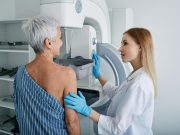Tag: Cancer: Breast
Risk Scores Generated by AI Algorithm Can ID Interval Breast Cancers
No differences seen among one-, two-, and three-year interval cancer predictions, age quartiles, or breast densities
Abemaciclib + Endocrine Therapy Improves Survival in HR-Positive, HER2-Negative Early Breast Cancer
15.8 percent lower risk for death seen with abemaciclib-ET versus ET in intent-to-treat population
Incidence Rates Increased From 2003 to 2017 for Six Cancer Types in 42 Countries
Apart from colorectal cancer, increases in incidence were seen in both younger and older adults
Estimates of Breast CA Risk for Pathogenic Variants Vary by Family Hx
Estimates for established pathogenic variants vary by family history and potentially modifiable risk factors
Incidence of Invasive Lobular Carcinoma Rose From 2012 to 2021
Authors say that because survival after seven years is lower, more early detection strategies are needed
Polygenic Risk Score 313 Can Predict Risk for Breast Cancer After In Situ Disease
Significant association seen for increasing continuous PRS313 and risk for contralateral disease after DCIS
Protein Markers of Inflammation Tied to Fatigue in Early-Stage Breast Cancer
Positive within-person associations seen between general fatigue and TNF-α, sTNF-RII, IL-6; and between physical fatigue and TNF-α, sTNF-RII, CRP
Skipping First Mammogram Screening Increases Long-Term Breast Cancer Mortality Risk
Higher mortality likely reflects delayed detection, not higher incidence
Elderly Patients Benefit From Screening Mammography
Women 80 years and older with screening more likely to present with earlier-stage disease and have better survival versus unscreened women
FDA Approves Inluriyo for Advanced Breast Cancer
Approval is for adults with ER-positive, HER2-negative, ESR1-mutated advanced or metastatic breast cancer














